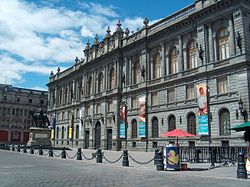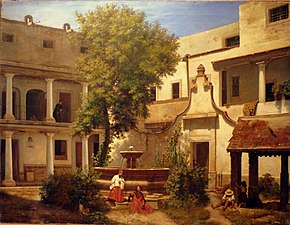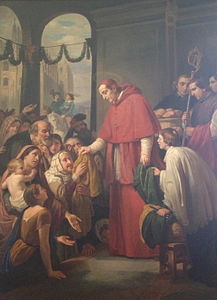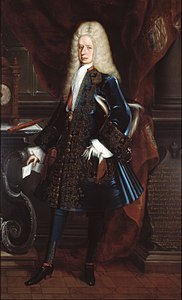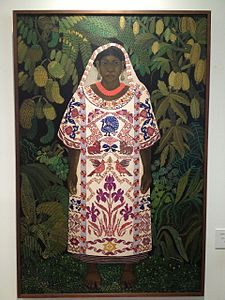
The Museo Nacional Centro de Arte Reina Sofía is Spain's national museum of 20th-century art. The museum was officially inaugurated on September 10, 1992, and is named for Queen Sofía. It is located in Madrid, near the Atocha train and metro stations, at the southern end of the so-called Golden Triangle of Art.

The Palacio de Bellas Artes is a prominent cultural center in Mexico City. This hosts performing arts events, literature events and plastic arts galleries and exhibitions. "Bellas Artes" for short, has been called the "art cathedral of Mexico", and is located on the western side of the historic center of Mexico City which is close to the Alameda Central park.

The Museo de Arte Moderno (MAM) is a museum dedicated to modern Mexican art located in Chapultepec Park in Mexico City.

The equestrian statue of Charles IV of Spain is a bronze sculpture cast by Manuel Tolsá built between 1796 and 1803 in Mexico City, Mexico in honour of King Charles IV of Spain, then the last ruler of the New Spain. This statue has been displayed in different points of the city and is considered one of the finest achievements of Mr. Tolsá. It now resides in Plaza Manuel Tolsá.
Adriano Buergo, is a Cuban artist specializing in painting, drawing and installations.

The Casón del Buen Retiro is an annex of the Museo del Prado complex in Madrid. Following major restoration work, which was completed in October 2007, it now houses the museum's study centre and library.
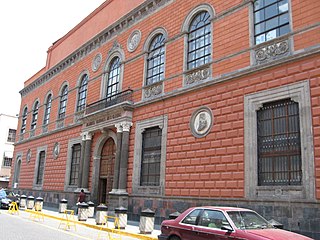
The Academy of San Carlos is located at 22 Academia Street in just northeast of the main plaza of Mexico City. It was the first major art academy and the first art museum in the Americas. It was founded in 1781 as the School of Engraving and moved to the Academia Street location about 10 years later. It emphasized the European classical tradition in training until the early 20th century, when it shifted to a more modern perspective.
Carlos Orozco Romero was a Mexican cartoonist and painter who co-founded several cultural institutions in Mexico, including the Escuela Nacional de Pintura, Escultura y Grabado "La Esmeralda". His work was recognized with membership in the Academia de Artes and the Salón de la Plástica Mexicana, and in 1980, with Mexico's Premio Nacional de Arte.

The Museum of Mexico City is located at Pino Suarez 30, a few blocks south of the Zocalo, on what was the Iztapalapa Causeway, near where Hernán Cortés and Moctezuma II met for the first time. This building used to be the palace of the Counts of Santiago de Calimaya, who were the descendants of one of the conquistadors with Cortés. The house was extensively remodeled during the colony to much the appearance that it has today and remained in the family until 1960, when the Mexico City government acquired it from them in order to found the Museum that is found there today. The museum contains a number of elements of the old palace as well as 26 rooms dedicated to the history and development of Mexico City from Aztec times to the present. It also contains a library and the studios of painter Joaquín Clausell, who lived here in the late 19th and early 20th centuries.
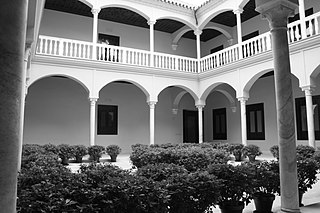
Buenavista Palace is a historical edifice in Málaga, Andalusia, Spain. It was built in the first half of the 16th century for Diego de Cazalla on the ruins of a Nasrid palace. Declared a "Property of Cultural Interest" in 1939, it was leased to the Spanish government in 1946 for a provincial art museum, which opened in 1961. In 1997 it was acquired to house the present Museo Picasso Málaga, which opened there in 2003. It is located in the historic center of Málaga, in the Calle San Agustín in the former Jewish quarter (judería), next to the San Agustín convent and not far from the Cathedral of Málaga.

The Museo de la Estampa is a museum in Mexico City, dedicated to the history, preservation and promotion of Mexican graphic arts. The word “estampa” means works in the various printmaking techniques which have the quality of being reproducible and include seals, woodcuts, lithography and others. The museum was created in 1986 and located in a 19th-century Neoclassical building located in the Plaza de Santa Veracruz in the historic center of the city. This building was remodeled both to house the museum and to conserve its original look.

Mariana Yampolsky was a Mexican-American photographer. A significant figure in 20th-century Mexican photography, she specialized in capturing photos of common people in everyday situations in the rural areas of the country. She was born in the United States, but came to Mexico to study art and never left, becoming a Mexican citizen in 1958. Her career in photography began as a sideline to document travels and work in the arts and politics, but she began showing her photography in the 1960s. From then until her death in 2002, her work was exhibited internationally receiving awards and other recognition both during her lifetime and posthumously.

Museo Nacional de las Culturas Populares is a museum in Mexico City dedicated to Mexico's ethnic and cultural diversity. This diversity not only includes that of its indigenous peoples, but also those of its regions and socioeconomic strata. It was founded in 1982 by anthropologist Guillermo Bonfil Batalla at a time when the country was accepting and promoting its cultural diversity. The museum does not have a large permanent collection but rather focuses on temporary exhibits, concerts, workshops and other cultural and educational events as well as promoting the creation of museums in Mexico to promote local cultures. The museum is also home to the Centro de Información y Documentación Alberto Beltrán, founded in 1971 to promote research and knowledge about Mexican handcrafts and folk art and indigenous ethnicities.
Gustavo Arias Murueta was a Mexican painter, sculptor and poet, a member of the Salón de la Plástica Mexicana best known for his work in drawing, graphic arts and oil painting. He originally studied architecture at the Universidad Nacional Autónoma de México where he met artists such as Rufino Tamayo, David Alfaro Siqueiros and José Clemente Orozco. In the 1950s, he began to produce artworks, with his first exhibition in 1961. From then until his death he had a career as an artist with individual and collective exhibitions in both Mexico and abroad. While his work had been heavily influenced by Orozco, he was considered part of the Generación de la Ruptura movement.

Vicente Gandía was a Mexican artist of Spanish origin who is best known for his depictions of nature and buildings. He originally trained to be an architect but abandoned this in favor of art, but with his art career beginning by drawing interiors. His major break came in 1968, with international expose which led to greater demand for his work. Recognitions for his art include membership in the Salón de la Plástica Mexicana, two awards from the same institution, a homage to the artist sponsored by the Instituto Nacional de Antropología e Historia while still alive and two others after his death, one with the Festival Internacional Cervantino.

Félix Parra Hernández (1845–1919) was an artist from Mexico who lived in the late 19th and early 20th centuries. During his life, Parra worked as an instructor of ornament drawing at the Academy of San Carlos, located in Mexico City. Through his compositions, Parra conveyed themes and narratives that demonstrated the changes in Mexican culture he experienced or observed during his time in the academy and critical world, providing a glimpse into history and shifting society from his perspective. Additionally, his works, particularly his images depicting natives, served as inspiration for later muralists such as Diego Rivera and José Clemente Orozco.

The National Museum of Ceramics and Decorative Arts "González Martí", located in Valencia, Spain, is a museum dedicated to ceramics, porcelains and other decorative arts such as textile art, traditional costumes and furniture.
Lourdes Alaniz is a Mexican painter and graphic artist whose work has been recognized with exhibition in Mexico’s Salón de la Plástica Mexicana.
Rocio Caballero is a Mexican figurative painter, whose works often depict mythical worlds and are noted for her use of symbolism. Her work has been exhibited individually and collectively in Mexico, the United States, South America and Europe and can be found in collections such as that of the National Museum of Mexican Art. Her work has been recognized with membership in the Salón de la Plástica Mexicana.
Miguel Ángel Rojas is a Colombian conceptual artist born in Bogotá in 1946. His work includes drawing, painting, photography, installations and video and is often related to the sexuality, the marginal culture, the violence and problems involved with drug consumption and production.
